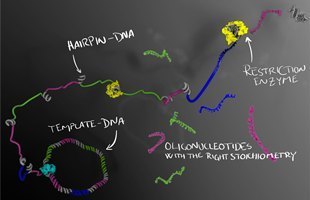New method of mass-producing highest-quality oligonucleotides enzymatically
See on Scoop.it – Virology and Bioinformatics from Virology.ca
A new method of manufacturing short, single-stranded DNA molecules can solve many of the problems associated with current production methods.
The new method can be of value to development of drugs consisting of DNA fragments and to DNA nanotechnology research.
The novel technique for manufacturing short, single-stranded DNA molecules — or oligonucleotides — has been developed by researchers at Karolinska Institute in Sweden and Harvard University.
Such DNA fragments constitute a basic tool for researchers and play a key part in many fields of science. Many of the recent advances in genetic and molecular biological research and development, such as the ability to quickly scan an organism’s genome, would not have been possible without oligonucleotides.
The new method is versatile and able to solve problems that currently restrict the production of DNA fragments.
“We’ve used enzymatic production methods to create a system that not only improves the quality of the manufactured oligonucleotides but that also makes it possible to scale up production using bacteria in order to produce large amounts of DNA copies cheaply,” says co-developer Björn Högberg at the Swedish Medical Nanoscience Center, part of the Department of Neuroscience at Karolinska Institutet in Sweden.
The process of bioproduction, whereby bacteria are used to copy DNA sequences, enables the manufacture of large amounts of DNA copies at a low cost. Unlike current methods of synthesising oligonucleotides, where the number of errors increases with the length of the sequence, this new method according to the developers also works well for long oligonucleotides of several hundred nitrogenous bases.
The DNA molecules are first formed as a long string of single-stranded DNA in which the sequence of interest is repeated several times. The long strand forms tiny regions called hairpins, where the strand folds back on itself. These hairpins can then be cut up by enzymes, which serve as a molecular-biological pair of scissors that cuts the DNA at selected sites. Several different oligonucleotides can thus be produced at the same time in a perfectly balanced combination, which is important if they are to be crystallised or used therapeutically.
“Oligonucleotide-based drugs are already available, and it’s very possible that our method could be used to produce purer and cheaper versions of these drugs,” says Dr Björn Högberg.
See on ki.se
